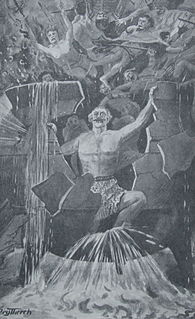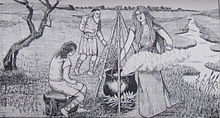
Fionn mac Cumhaill, often anglicized Finn McCool or MacCool, is a hero in Irish mythology, as well as in later Scottish and Manx folklore. He is leader of the Fianna bands of young roving hunter-warriors, as well as being a seer and poet. He is said to have a magic thumb that bestows him with great wisdom. He is often depicted hunting with his hounds Bran and Sceólang, and fighting with his spear and sword. The tales of Fionn and his fiann form the Fianna Cycle or Fenian Cycle, much of it narrated by Fionn's son, the poet Oisín.

Ragnar Lodbrok, according to legends, was a Viking hero and a Danish and Swedish king. He is known from Old Norse poetry of the Viking Age, Icelandic sagas, and near-contemporary chronicles. According to the traditional literature, Ragnar distinguished himself by conducting many raids against the British Isles and the Holy Roman Empire during the 9th century. He also appears in Norse legends, and according to the legendary sagas Tale of Ragnar's Sons and a Saga about Certain Ancient Kings, Ragnar Lodbrok's father has been given as the legendary king of the Swedes, Sigurd Ring.

Gwydion fab Dôn is a magician, hero and trickster of Welsh mythology, appearing most prominently in the Fourth Branch of the Mabinogi, which focuses largely on his relationship with his young nephew, Lleu Llaw Gyffes. He also appears prominently in the Welsh Triads, the Book of Taliesin and the Stanzas of the Graves.

Pryderi fab Pwyll is a prominent figure in Welsh mythology, the son of Pwyll and Rhiannon, and king of Dyfed after his father's death. He is the only character to appear in all Four Branches of the Mabinogi, although the size of his role varies from tale to tale. He is often equated with the divine son figure of Mabon ap Modron, while Jeffrey Gantz compares him to Peredur fab Efrawg, who is himself associated with the continental figure of Sir Percival de Galles.

Efnisien fab Euroswydd is a sadistic anti-hero in Welsh mythology, appearing prominently in the tale of Branwen ferch Llŷr, the second branch of the Mabinogi. Described by Will Parker as "a study in the psychopathic personality" and an "embodiment of the forces of anti-social disruption," he is the catalyst of the tale's ultimate tragedy, and is largely responsible for the destruction of both Ireland and the Island of the Mighty. He is the son of Euroswydd and Penarddun, twin brother to Nisien, and half-brother to Brân the Blessed, Manawydan, and Branwen. The Welsh Triads call Llŷr one of the Three Exalted Prisoners of Britain for his captivity at Euroswydd's hands; this is likely to a lost tradition of the birth of Penarddun's younger sons.
Ceridwen or Cerridwen was an enchantress in Welsh medieval legend. She was the mother of a hideous son, Afagddu, and a beautiful daughter, Creirwy. Her husband was Tegid Foel and they lived near Bala Lake in north Wales. Medieval Welsh poetry refers to her as possessing the cauldron of poetic inspiration (Awen) and the Tale of Taliesin recounts her swallowing her servant Gwion Bach who is then reborn through her as the poet Taliesin. Ceridwen is regarded by many modern pagans as the Celtic goddess of rebirth, transformation, and inspiration.
In Welsh mythology, Elffin ap Gwyddno was a son of Gwyddno Garanhir, 'Lord of Ceredigion'. The earliest example of the name occurs in several of the mythological poems attributed to Taliesin in the Book of Taliesin. The date of their composition is uncertain but probably predates the Norman conquest. Several late medieval compositions refer to Elffin and Taliesin in more detail.
Maelgwn Gwynedd was king of Gwynedd during the early 6th century. Surviving records suggest he held a pre-eminent position among the Brythonic kings in Wales and their allies in the "Old North" along the Scottish coast. Maelgwn was a generous supporter of Christianity, funding the foundation of churches throughout Wales and even far beyond the bounds of his own kingdom. Nonetheless, his principal legacy today is the scathing account of his behavior recorded in De excidio et conquestu Britanniae by Gildas, who considered Maelgwn a usurper and reprobate. The son of Cadwallon Lawhir and great grandson of Cunedda, Maelgwn was buried on Ynys Seiriol, off the eastern tip of Anglesey, having died of the "yellow plague"; quite probably the arrival of Justinian's Plague in Britain.
Taliesin was an early Brittonic poet of Sub-Roman Britain whose work has possibly survived in a Middle Welsh manuscript, the Book of Taliesin. Taliesin was a renowned bard who is believed to have sung at the courts of at least three kings.

Amleth is a figure in a medieval Scandinavian legend, the direct inspiration of the character of Prince Hamlet, the hero of William Shakespeare's tragedy Hamlet, Prince of Denmark. The chief authority for the legend of Amleth is Saxo Grammaticus, who devotes to it parts of the third and fourth books of his Gesta Danorum, completed at the beginning of the 13th century. Saxo's version is similar to the one in the 12th-century Chronicon Lethrense. In both versions, prince Amleth (Amblothæ) is the son of Horvendill (Orwendel), king of the Jutes. It has often been assumed that the story is ultimately derived from an Old Icelandic poem, but no such poem has been found; the extant Icelandic versions, known as the Ambales-saga, or Amloda-saga are considerably later than Saxo.
Morfran is a figure in Welsh mythology. Usually portrayed as a warrior under King Arthur, he is noted for the darkness of his skin and his hideousness. He appears in the narratives about the bard Taliesin and in the Welsh Triads, where he is often contrasted with the angelically handsome Sanddef.

Welsh mythology consists of both folk traditions developed in Wales, and traditions developed by the Celtic Britons elsewhere before the end of the first millennium. As in most of the predominantly oral societies Celtic mythology and history were recorded orally by specialists such as druids. This oral record has been lost or altered as a result of outside contact and invasion over the years. Much of this altered mythology and history is preserved in medieval Welsh manuscripts, which include the Red Book of Hergest, the White Book of Rhydderch, the Book of Aneirin and the Book of Taliesin. Other works connected to Welsh mythology include the ninth-century Latin historical compilation Historia Brittonum and Geoffrey of Monmouth's twelfth-century Latin chronicle Historia Regum Britanniae, as well as later folklore, such as the materials collected in The Welsh Fairy Book by William Jenkyn Thomas (1908).
Awen is a Welsh, Cornish and Breton word for "inspiration".

The Salmon of Knowledge is a creature in the Fenian Cycle of Irish mythology, sometimes identified with Fintan mac Bóchra, who was known as "The Wise" and was once transformed into a salmon.

"The White Snake" is a German fairy tale collected by the Brothers Grimm and published in Grimm's Fairy Tales. It is of Aarne–Thompson type 673, and includes an episode of type 554.

Preiddeu Annwfn or Preiddeu Annwn is a cryptic poem of sixty lines in Middle Welsh, found in the Book of Taliesin. The text recounts an expedition with King Arthur to Annwfn or Annwn, the Welsh name for the Celtic Otherworld.
The Boyhood Deeds of Fionn is a medieval Irish narrative belonging to the Fenian Cycle of Irish mythology. As its title implies, it recounts the boyhood exploits of Fionn mac Cumhaill, the cycle's central figure.

The Misfortunes of Elphin (1829) is a short historical romance by Thomas Love Peacock, set in 6th century Wales, which recounts the adventures of the bard Taliesin, the princes Elphin ap Gwythno and Seithenyn ap Seithyn, and King Arthur. Peacock researched his story from early Welsh materials, many of them untranslated at the time; he included many loose translations from bardic poetry, as well as original poems such as "The War-Song of Dinas Vawr". He also worked into it much satire of the Tory attitudes of his own time. Elphin has been highly praised for its sustained comic irony, and by some critics is considered the finest Arthurian literary work of the Romantic period.

Lagertha, according to legend, was a Viking ruler and shield-maiden from what is now Norway, and the onetime wife of the famous Viking Ragnar Lodbrok. Her tale was recorded by the chronicler Saxo in the 12th century. According to the historian Judith Jesch, Saxo's tales about warrior women are largely fictional; other historians wrote that they may have a basis in tales about the Norse deity Thorgerd.
Creirwy is a figure in the Mabinogion and the Hanes Taliesin, daughter of the enchantress Ceridwen and Tegid Foel. The Welsh Triads name her one of the three most beautiful maids of the Isle of Britain. Born in Penllyn in Powys, Wales, Creirwy has a dark, hideous brother named Morfran and a foster brother, Gwion Bach. She does not appear in the stories about Afagddu and Taliesin.











